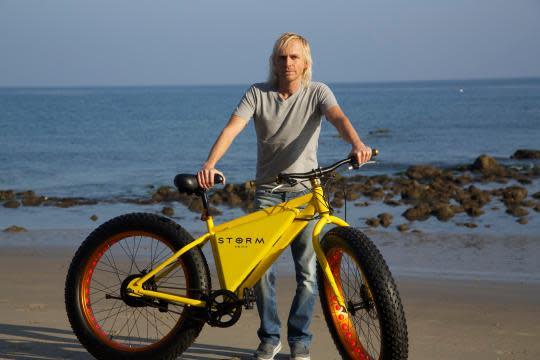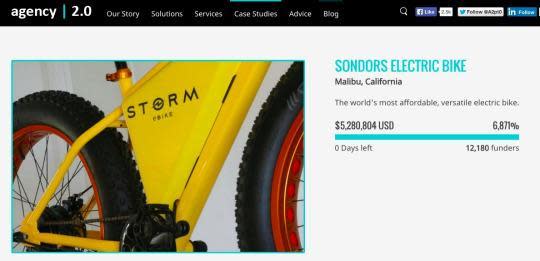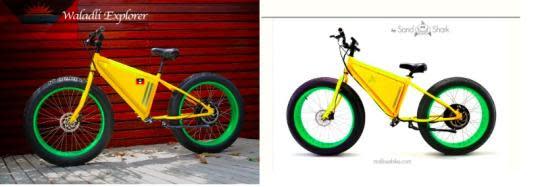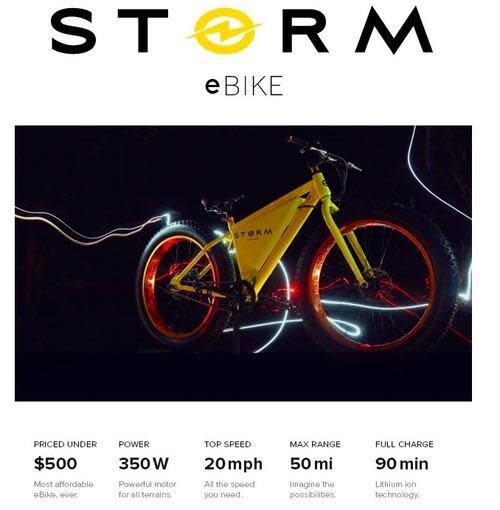The Strange, Unlikely Saga of the ‘$500’ Storm eBike
In February, an out-of-nowhere crowdfunding campaign took the world by storm.
The goal of that campaign: to fund the development of a $500 electric bike that could go 20 miles per hour and run for 50 miles on a single charge. The idea captivated donors to a degree even its creators probably hadn’t imagined. The campaign raised millions overnight, generated buckets of controversy, and led to a series of legal disputes that persist to this day.

“Storm” Sondors with the Storm/Sondors eBike on the beach at Malibu. (Photo: Indiegogo)
Now, to the surprise of many, the campaign appears to have delivered some actual bikes — though the bikes themselves fail to deliver on some of the campaign’s original promises.
It’s been a wild ride, in every sense of the word.
The gathering storm
In February, the Storm eBike campaign launched on Indiegogo. For five days, early backers could preorder an e-bike for the unprecedented price of $500, plus roughly $200 in shipping. The cost would then go up to $600 for a period, then $650, and eventually up to a list price of $1,300. (Competing e-bikes can typically cost north of $2,000.)
The goal was to raise $75,000 to launch the e-bike company. Thanks at least in part to an article about the e-bike that appeared on the Yahoo homepage, however, the campaign raised more than $4 million within four days and a grand total of $6.1 million when an additional campaign concluded earlier this month. Thousands of people, many of whom had never contributed to a crowdfunding campaign before, kicked in $500 or more for a chance to get their hands on the Storm.
But the campaign also generated more than its share of controversy. Electric bike experts contacted by Yahoo Tech raised doubts about whether the campaign could deliver on the promises it was making. Others questioned the identities of the men who claimed to have invented the e-bike, “Storm” Sondors and Jon Hopp. Within two days, the campaign received a cease-and-desist letter from Prodeco Technologies of Fort Lauderdale, Fla., which already selling an electric bike called the Storm. (Shortly afterward, the campaign renamed it the Sondors eBike.)
The PR agency that managed the campaign, Agency 2.0, launched an advertising and media blitz to convince the public that the bike and its creators were legit. A few weeks in, co-founder Hopp was quietly removed from the Indiegogo campaign. He says he is still awaiting a formal offer from Sondors to buy out his interest in the venture.

The Storm/Sondors Indiegogo campaign is still listed as a ‘success story’ on Agency 2.0’s website, despite a lawsuit. (Photo: Agency 2.0)
About a month later, Agency 2.0 filed suit against Sondors and his company, Pacific Storm, claiming that he refused to pay them their cut of the fundraising — more than $600,000. That suit is still wending its way through Los Angeles Superior Court.
The episode has raised a slew of questions: Who were these guys? Could they really deliver thousands of e-bikes at such a low price? Would everyone who’d paid for one of their e-bikes actually receive one?
Now, more than six months later, we finally have some answers.
Who are these guys?
According to his biography on the Indiegogo campaign, the Latvian-born Sondors — his real name is Ivars Sondors — spent part of his career designing toys for McDonald’s Happy Meals. That seems plausible: For several years in the 2000s, Sondors was president of A-HA Toys, based in Lake Geneva, Wis., and Chicago. He holds patents on a handful of toys, including a helicopter and a set of dice.

In happier times: the two original founders of the Storm/Sondors eBike Indiegogo campaign. (Photo: Indiegogo)
Hopp is a film editor and producer in Los Angeles. He made the slick videos and photos that helped to make the fundraising campaign such a success. However, Hopp says that once the money started flowing in, he was pushed aside; his face and name were quietly removed from the Indiegogo campaign.
According to a company spokesperson, “Jon Hopp is an e-bike enthusiast who was excited about the initial Sondors concept, but he has no official involvement in the campaign.”
Did Storm actually ‘invent’ the bike?
According to the Sondors website, “Storm envisioned the bike after he suffered an accident that temporarily limited his mobility that affected his outdoors/beach way of life.” But the people I contacted tell a different story.
Hopp says he built the original prototype himself with the help of a friend, using a frame he obtained from a fat-tire-bicycle manufacturer in Florida. (Yahoo Tech confirmed this information with the maker of the frames, who requested anonymity.) Hopp says he poured more than $6,300 of his own money into building the prototype before Sondors, his Malibu neighbor, even saw it. Sondors then suggested the idea of creating a low-cost version of the bike and turning it into a business. That $6,300 prototype was featured prominently in videos promoting the Indiegogo campaign.

Two early incarnations of what ultimately became the Sondors eBike, posted to Jon Hopp’s Facebook page in summer 2014. (Photo: Facebook)
The company’s version of the story? “Fat tire e-bikes existed before but not like the price and particular embodiment of the Sondors eBike.”
Is the bike real?
Yes. There are multiple posts online showing happy crowdfunding backers posing next to their Sondors bikes. According to a spokesperson, the company has shipped 6,630 bikes so far to customers in the U.S., Europe, Australia, and South America.
The site ImportGenius.com — which pulls import data directly from bills of lading as container ships pass through U.S. Customs — offers a slightly lower figure: It says 5,710 Sondors bikes made their way from China to Los Angeles since June 1. Still, that’s an impressive number of units for a first-time e-bike maker to move in such a short time.
The next question: How many bikes are still owed to backers? Pacific Storm says less than a thousand remain to be shipped. However, according to Hopp, approximately 9,000 bikes were promised to campaign backers, which would mean at least 2,300 remain to be distributed. Yahoo Tech has contacted Indiegogo asking for the exact number of bikes promised to supporters, which is no longer available on the campaign website; we’re still awaiting a reply.
Did it really cost just $500?
Not really. Though more than 5,000 bikes were preordered as Indiegogo perks at $499 apiece, shipping from China added between $194 and $247 to that base price. Later in the campaign, the perk price rose to $599 and $649, plus shipping. Many backers purchased extra batteries for $179 plus $50 shipping, and at least 54 people spent another $120 on nonrefundable insurance from Indiegogo, so they could get their money back in case the bike never shipped.
Even with all that, however, the Sondors eBike was still way less expensive than most entry-level e-bikes.
Did it do everything Sondors claimed it would?
That depends on which claims you look at. The initial specifications posted for the bike — which were instantly questioned by e-bike experts — proved a bit too ambitious.

The original specs for the Storm eBike, posted to Indiegogo; these would later be revised a few times. (Photo: Indiegogo)
The bike was initially advertised as weighing 45 pounds; the shipping unit clocked in at nearly 60 pounds. According to the original specs, the bike would go up to 20 miles per hour, achieve a maximum range of 50 miles, and recharge in about 90 minutes. The campaign gradually downgraded most of these specs — for example, the 50-mile range became 30 to 50 miles with pedal assist — but mostly failed to meet even those claims.
Court Rye, owner of Electric Bike Review, gave the Sondors bike a thorough test drive. He found that it topped out at 18 mph on flat terrain, ran out of juice at around 15 miles, and took 4 hours to recharge. (Other reviewers have reported ranges between 20 and 25 miles on flat terrain without pedal assist; one Sondors owner reported getting the promised 50 miles — pedaling the entire way.)
Rye also noted that support for the bike ranged from poor to nonexistent, a complaint voiced by others online. On the other hand, Rye adds that the shipping version of the bike offered better throttle controls, sensors, and LED readouts than were advertised.
Are customers happy?
They seem to be. Facebook groups and bike blogs are filled with positive accounts. One member of the private Sondors Storm Owners Group on Facebook, Josh Rafofsky, wrote to Yahoo Tech recently to share his story:
“I was the first to report receiving their Sondors. … It’s everything I expected it would be, and more. I love this thing. It’s made me a cyclist again. I haven’t had this much fun riding a bike since I was a teenager (I’m now in my early 40s.) … I wake up in the morning asking myself, ‘Where can I ride my eBike to today?’ It’s seriously a game changer for me.”
Can you still get one?
The campaign is over, and the production run has sold out, but you can sign up for the waiting list at the Go Sondors website. However, depending on how many of the bikes have been shipped, you could find yourself waiting a long time to get yours.
More about the Storm eBike and crowdfunding:
We’re Crowdfunding a Time Machine. Please Give Us Your Money
10 Things You Must Know Before Investing in That Crazy Crowdfunding Scheme
Send email to Dan Tynan here or follow him on Twitter.
